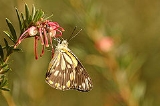
Belenois java
Encyclopedia
Belenois java, the Caper White or Common White, is a small-sized butterfly of the family Pieridae
found in Australia
, Indonesia
, and Melanesia
. It is highly migratory and is often confused with the Cabbage White (Pieris rapae).
), Dog caper (Capparis canescens), Nipan (Capparis lasiantha), Australian native orange (Capparis mitchellii
), Wild orange (Capparis sepiaria), Australian native caper (Capparis spinosa) and Bush orange (Capparis umbonata). Unlike other caterpillars of its size the B. java feeds on a fairly minimal amount of food, making it less of an agricultural pest than the others. The caterpillars feed for about three weeks until fully grown and pupate. They emerge around December in much of its range.
Pieridae
The Pieridae are a large family of butterflies with about 76 genera containing approximately 1,100 species, mostly from tropical Africa and Asia. Most pierid butterflies are white, yellow or orange in coloration, often with black spots...
found in Australia
Australia
Australia , officially the Commonwealth of Australia, is a country in the Southern Hemisphere comprising the mainland of the Australian continent, the island of Tasmania, and numerous smaller islands in the Indian and Pacific Oceans. It is the world's sixth-largest country by total area...
, Indonesia
Indonesia
Indonesia , officially the Republic of Indonesia , is a country in Southeast Asia and Oceania. Indonesia is an archipelago comprising approximately 13,000 islands. It has 33 provinces with over 238 million people, and is the world's fourth most populous country. Indonesia is a republic, with an...
, and Melanesia
Melanesia
Melanesia is a subregion of Oceania extending from the western end of the Pacific Ocean to the Arafura Sea, and eastward to Fiji. The region comprises most of the islands immediately north and northeast of Australia...
. It is highly migratory and is often confused with the Cabbage White (Pieris rapae).
Adult
The upper surface of the male's wings are white with a broad black apical patch, the hindwing has a black terminal border. On both wings the black area encloses white dots. The under surface of the hindwing is almost exclusively black except for white and yellow patches between the veins. The wingspan on the male is 5 cm where as the female's wingspan is larger at 6 cm. The female can vary dramatically including a pale form which looks strikingly similar to the males. The upper surface of the wings are white and have a much broader black margin. The body of both is olive green to dark brown.Immature
The first instar of this species is pale yellow sparsely covered in long hairs. The later instars of this species are dark brownish-green with white and yellow raised spots. The head has a V-shaped white mark and is shiny black. There are two lines of hair on the side of the caterpillar's 3 cm body in its later stages. The pupa is white with black markings and is about 2.5 cm. Eggs are small and orange.Life cycle
Eggs are laid in groups on the top of the host plant's leaves. The caterpillar feeds on Currant bush (Apophyllum anomalum), Scrub caper berry (Capparis arboreaCapparis arborea
Capparis arborea is a bush or small tree occurring in eastern Australia. The habitat is rainforest; usually riverine, littoral or the drier rainforests. Distributed from the Hunter River, New South Wales to Cape Melville in tropical Queensland...
), Dog caper (Capparis canescens), Nipan (Capparis lasiantha), Australian native orange (Capparis mitchellii
Capparis mitchellii
The "Wild Orange" is an Australian native plant. Its scientific name is Capparis mitchellii; it is not related to oranges and neither to the Osage-orange which is known as "wild orange" in North America, but to capers. Its name in the Arrernte language of Central Australia is merne atwakeye.Wild...
), Wild orange (Capparis sepiaria), Australian native caper (Capparis spinosa) and Bush orange (Capparis umbonata). Unlike other caterpillars of its size the B. java feeds on a fairly minimal amount of food, making it less of an agricultural pest than the others. The caterpillars feed for about three weeks until fully grown and pupate. They emerge around December in much of its range.

